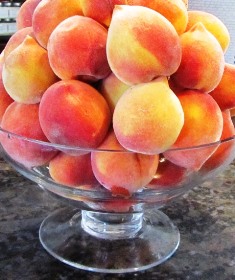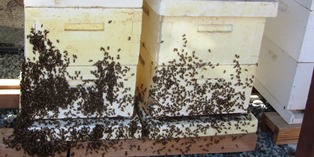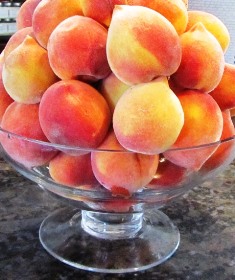Country Fresh Peach Cobbler
Ripe peaches, widely available throughout summer, are delicious in cobblers, pies, and pancakes. They are scrumptious in spreads like jam for toast, on pound cake drizzled in brand or a fruit wine, or over warm bread. Alternatively, pile ripe peaches into a pandowdy, tart, galette, or crostini (the French and Italian versions of a rustic one-crust pie with edges folded over to hold in the fruit).
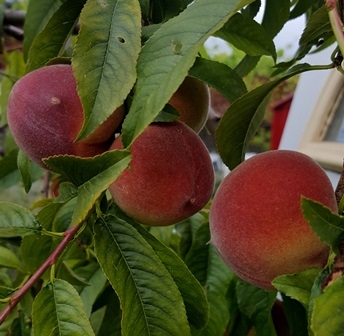
Folks in the Midwest where I grew up enjoy peach cobbler best when served warm with rich vanilla ice cream or piled high with homemade whipped cream. Of course, this cobbler is especially tasty served cold when flavors have time to marinate. To ensure freshness, always refrigerate.

For this peach cobbler recipe, you’ll need about two and one-half pounds of fresh, ripe peaches. Gather your tools, bowls, and ingredients. Preheat the oven to 350 degrees Fahrenheit.
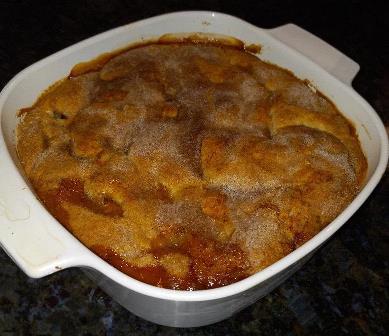
RECIPE: COUNTRY FRESH PEACH COBBLER
Ingredients:
1 cup flour
2 teaspoons baking powder
1/2 cup sugar
6 Tablespoons cold, unsalted butter, cut into cubes
1 large egg, lightly beaten
1/4 cup Half & Half
2 1/2 pounds fresh peaches (peeled, pitted, and sliced)
2 Tablespoons fresh lemon juice
2 Tablespoons apricot preserves
1 teaspoon ground nutmeg or mace and 1/2 teaspoon ground cinnamon for peach filling
1/2 teaspoon ground cinnamon mixed with 2 Tablespoons sugar for topping
Directions to Make Crust
Divide sugar into two equal portions. In a large bowl, pour in the flour, baking powder, and one portion of the sugar. Mix the ingredients until thoroughly combined. Cut four tablespoons of the butter into cubes. Drop pieces of butter into the dry ingredients. Using a pastry cutter or your fingers, integrate the butter into the dry ingredients until the mixture is crumbly. In a separate bowl, beat together egg and Half & Half. Slowly pour this into the dry flour mixture and mix until the dough is moistened, not wet. On a piece of plastic wrap that has been sprinkled with a little sifted flour, shape the dough into a ball, cover with plastic wrap, and refrigerate for 15 minutes.
Directions for Preparing the Peaches
In a medium-size bowl, mix the peeled, pitted, and sliced peaches with lemon juice, nutmeg (or mace), 1/2 teaspoon cinnamon, apricot preserves, and the remaining portion of sugar. In a 1 1/2 quart baking dish, pour in the peach filling. Cut the remaining butter into pieces and add to the peaches.
Directions for Assembling the Cobbler.
Roll out the cobbler dough and place it so that it covers the peaches and stretches to the edge of the baking dish. Seal by crimping the dough around the edges of the dish. Cut vents into the dough. Then sprinkle the cinnamon and sugar mixture over the top of the crust. Bake 30 to 35 minutes. Remove when crust has browned and let cool. Serve with ice cream or whipped cream.
If you enjoy reading about country living, check out the novels based on my farmette life: A Beeline to Murder, The Murder of a Queen Bee, and A Hive of Homicides. All are available from Amazon, Barnes & Noble, and other online retailers as well as bookstores everywhere.

It’s Summer . . . Let’s Have Fresh Peach Cobbler
The peaches are ripe now and beginning to fall from the tree. I decided to whip up a fresh peach cobbler from scratch. It’s easy and won’t take more than 15 to 20 minutes to get the cobbler made and into the oven.
All you need to make this super-simple summer dessert are a few fresh peaches and a basic cobbler batter.

The cobbler crust forms as the fruit and batter bake. The dessert is even tastier with a scoop of vanilla ice cream.
RECIPE: FRESH PEACH COBBLER
Ingredients:
1/2 cup unsalted butter, melted
1 cup all-purpose flour
2 cups granulated sugar
3 teaspoons baking powder
pinch of salt
1 cup of milk
5 to 6 medium to large fresh peaches (peeled, pitted, and sliced)
1 tablespoon fresh lemon juice
1 teaspoon cinnamon or ground nutmeg (optional)
Directions:
Preheat oven to 375 degrees Fahrenheit
Select a baking dish that measures 13 x 9 x 2 inches and pour the melted butter to coat the bottom.
Combine in a medium bowl the dry ingredients (set aside 1 cup of sugar for the peaches). Pour the milk over the dry mixture and stir gently to combine to create a batter. Do not overmix. Pour the batter into the butter-coated baking dish.
Put peaches into a saucepan and cover with the remaining cup of sugar and lemon juice. Over high heat, bring the peaches to a boil, stirring constantly. Remove from heat and pour the peaches over the batter in the baking dish, but do not stir.
Sprinkle the cinnamon and/or nutmeg over the fruit. Bake for 45 to 50 minutes. The cobbler batter will become a crusty topping through which the hot peach filling bubbles through. Serve it hot or cold, plain or with a dollop of whipped cream or a scoop of rich vanilla ice cream. Serves 4-6
Puzzling through a Cozy, Weeping at a Memoir, and Forgetting the Peach Pie
I couldn’t breathe in yesterday’s heat. But with so much work to be done around the farmette, I soldiered on, staking heirloom blue tomatoes. I hadn’t finished canning my organic apricots and now the plums and peaches were ready. I felt overwhelmed and longing for cool spot to sip tea, rest, and read.
We had already removed the apricots from our “torture tree” since we’ve been unable to surmount its many problems after planting it five years ago. Carlos wasted little time chain-sawing it down. I deadheaded the roses, while he dug out the stump.
Then with a clear view to our hives, we quickly realized that the we needed to suit up and install extenders or the bees would swarm. Even as we felt the urgency, we realized there were also dozens of other chores screaming for our attention.
I told myself that breezes would soon blow inland from the Carquinez Strait, a channel of the San Francisco Bay where the San Joaquin and the Sacramento Rivers flow to the ocean, but by mid-afternoon, nary a leaf moved on the apricot, plum, and pomegranate trees. By four o’clock when the wind finally did kick in–the air wasn’t cool as it usually was. The winds blew strong and stifling hot and threatened to suffocate anyone still working outside.
Abandoning the outside chores, I retreated indoors and turned on the air conditioner. Seeing the lug of apricots and crock of peaches resting on the kitchen counter, I groaned. The jam had to be made, but I couldn’t face stirring boiling fruit on a hot stove.
Deciding to use up some of the fruit for a simple after-dinner dessert, I flipped through the pages of a few cookbooks. Maybe a cobbler would do or a peach pie. I really didn’t need a recipe for those, but in Country Cooking by Dori Sanders, I found an intriguing raisin-cinnamon crust that sounded tasty. I bet it would go with peaches but I probably could have baked it on the patio floor.
With a glass of sweet tea and an armload of paperbacks and hardcovers, I curled up on the couch and finished reading Murder is Binding, Lorna Barrett’s debut book in her cozy Booktown Mystery series. I love this author and her writing, but soon figured out who done it. Still, I read to the end; you never know when a clever twist might show up.
Next, I read the last few pages of A Tuscan Childhood by Kinta Beevor. At bedtime, I’d been savoring the chapters of that book like pieces of rich, dark chocolate. Beevor’s evocative descriptions of her bohemian childhood in Tuscany captured my imagination, drawing me in so completely I could almost smell the wild thyme, pine needles, and rocky Tuscan terrain in the searing, summer heat. Like Frances Mayes (Under the Tuscan Sun), who wrote a quote for the cover, I felt sad when Beevor’s lovely memoir ended.
Returning to the stack, I selected another memoir, The Orchard, by Theresa Weir. I’d bought the book on impulse during a trip to the farmers’ market at Todos Santos Plaza, our downtown green space surrounded by bars and banks and, of course, a second-hand bookstore. Drastically marked down, the book had been summarily deposited on a set of moveable shelves, and rolled outside the storefront for a quick sale.
The artist and writer in me understood immediately why I had picked it up and purchased it: the cover art pictured a young couple in a loving embrace, standing in lush green grass surrounded by apple trees. But there was something in that image that evoked sadness, like a bittersweet dream of a time past, viewed through a long lens.
As the descendant of five generations of farmers, I suspected Weir’s book would resonate with my own experiences of farm life in America’s heartland with bone-chilling winters of snow and ice and sweltering summers when you prayed for rain. What I didn’t expect was exquisite writing and the juxtaposition of love against the deadly realities of widespread pesticide use on the farms that ushered me into her story and swept me along. I finished that book in one sitting and will long be haunted by it.
I felt guilty for having only paid pennies for Weir’s book. A pittance for a tale that evolved out of all she had lived through. Less than the price of bus fare to journey with her as she pieced together scenes from her life in the Heartland. In every page, I was with her as she struggled, never abandoning her dreams. She learned as I had how to tuck them away while you dealt with the realities of a hard life with heart-breaking lows and highs that reached euphoria. But there were scenes she left out, only hinting at experiences she said she would “never talk about.” The truth is, I wept after putting down her book.
When a reader identifies so closely with a character in a story (and this was Weir’s personal narrative of her life), he or she rides the emotional ups and downs with that character. Good writers understand how to tug at their readers’ emotions and milk the drama. Theresa Weir had skillfully threaded a leitmotif of darkness and light, joy and sorrow, pain and healing through her story, but never once did I feel manipulated. Every sentence of The Orchard rang true.
I couldn’t read anymore after putting that book down. As I made dinner, I thought of how many scenes in her life resonated with mine. Even the widespread pesticide use on farms and the stubbornness of farmers to change.
I thought about Rachel Carson’s famous book, Silent Spring, that sounded the wake-up call to farmers everywhere about the dangers of chemicals in fertilizers, pesticides, and herbicides. So many small farms have been overtaken by agribusinesses these days and still the chemicals are used. I decided to forgo making the peach pie.
With the heat of the day gone, I opened the windows and stretched out between freshly washed sheets. I listened to the rustle of oak and eucalyptus leaves. To crickets and the unseen critters that make noises in the night. I listened to the soft voices of my Lebanese neighbors chatting in their orchard with relatives.
As dreams beckoned, I could almost smell the fresh lilacs that Theresa Weir had written about in her memoir. Their cloying scent had filled her grandmother’s kitchen just as they had filled my grandmother’s, my mother’s, and mine. I wondered if the lilacs would ever disappear or if the world would one day wake up to find the honeybees gone, the fruit trees without fruit, and the berries and other sweet produce in our gardens and orchards reduced to a memory.
 Facebook
Facebook Goodreads
Goodreads LinkedIn
LinkedIn Meera Lester
Meera Lester Twitter
Twitter





